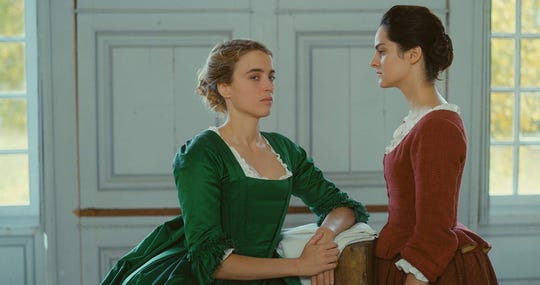‘Portrait of a Lady on Fire’ Is A Stunning Work of Art

by Sarah Nove ‘20
There are films that you watch, and, a week or two later, you forget. Then there are films that make an impression, but after a few years, the emotions they evoked grow hazy in your mind. Finally, there are movies that grab you, burrowing deep into your soul, and stay there, embedded in your memory. In my opinion, “Portrait of a Lady on Fire” falls into the third category.
Now, I say “in my opinion,” because I know this is not a film for everyone. “Portrait” is a French arthouse film about two women falling in love in the eighteenth century––it appeals to a niche audience. An audience that, to be frank, I did not expect to be a part of. Loads of critics threw praise at this film, placing it in their ‘best of’ lists for female directors. But, being the cynic that I am, I was concerned: if you took the word “female” out of the equation, would it still hold up? Would “Portrait” be another lesbian love story that only explores romance between women from a superficial (sexual) perspective?
Céline Sciamma, the screenwriter and director behind “Portrait,” took those concerns and threw them straight into the fireplace. “Portrait” is not only an incredible female-directed lesbian film––it is an incredible film, period. It is quiet, but never boring. It is gorgeous, but never gaudy. It is contemplative, but never pretentious. It is everything a great arthouse film should be.
That’s a lofty statement, I know, but I love this film. It has so much to love. First of all, the visuals––my goodness, the visuals! Claire Mathon’s cinematography captures the beauty of falling in love, using bright colors that interrupt the muted hues of oppression which surround the lovers, Marianne (Noémie Merlant) and Héloïse (Adèle Haenel). The costumes and sets are stunning, but just subtle enough so that they never distract from the understated gestures of the two actresses.
Merlant and Haenel melt into their roles, embodying their characters with amazing earnestness. Every slight motion, from the movement of a finger to the tilt of an eyebrow, appears organic. For her part, Sciamma brings out the vulnerability in Merlant and Haenel. She creates an atmosphere of complete authenticity through stretches of silence and intense looks that communicate in ways words could not.
But more important than any of those elements is the narrative itself. The story conveys the tensions and uncertainties of a budding relationship, while also articulating the joy and growth that love brings. “Portrait of a Lady on Fire” is a bittersweet mix of hope, sorrow, anger, laughter, and forgiveness––it is love in a runtime of 120 minutes, and I adored every second of it.
Grade: A+
